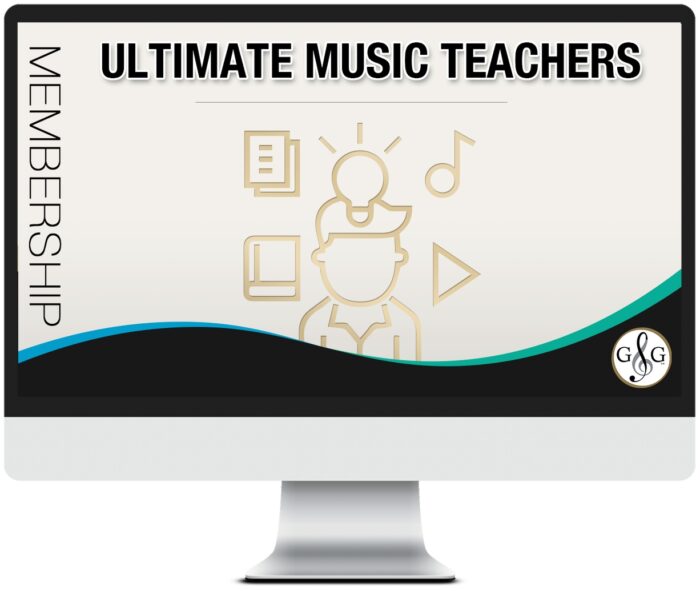How to Teach Music Theory Beginner A Lesson 9
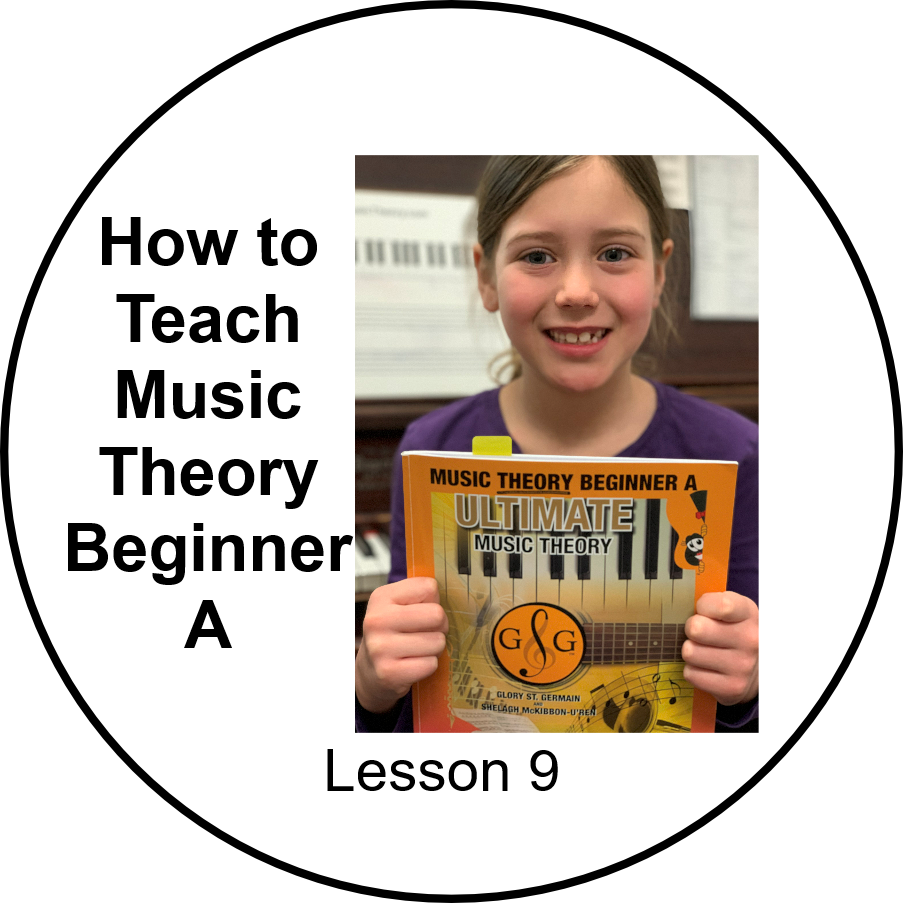
Welcome to the How to Teach Ultimate Music Theory Beginner A Workbook Series - Lesson 9 - Treble Clef.
The Ultimate Music Theory Beginner A, B and C Workbook Series is the perfect theory supplement for Beginner Students (ALL ages, ANY instrument). The UMT Beginner A, B, C Series works with every Method Series and with every Learning Style.
In this Blog, we will look at how to teach the concepts in the Music Theory Beginner A Workbook Lesson 9. Remember to read the first 9 Blogs in this series:
Music Theory Beginner A Overview
Music Theory Beginner A - Lesson 1
Music Theory Beginner A - Lesson 2
Music Theory Beginner A - Lesson 3
Music Theory Beginner A - Lesson 4
Music Theory Beginner A - Lesson 5
Music Theory Beginner A - Lesson 6
Music Theory Beginner A - Lesson 7
Music Theory Beginner A - Lesson 8
Join me as we explore tips and tricks to incorporate theory, ear training, sight reading and games into every lesson. Let's jump in!
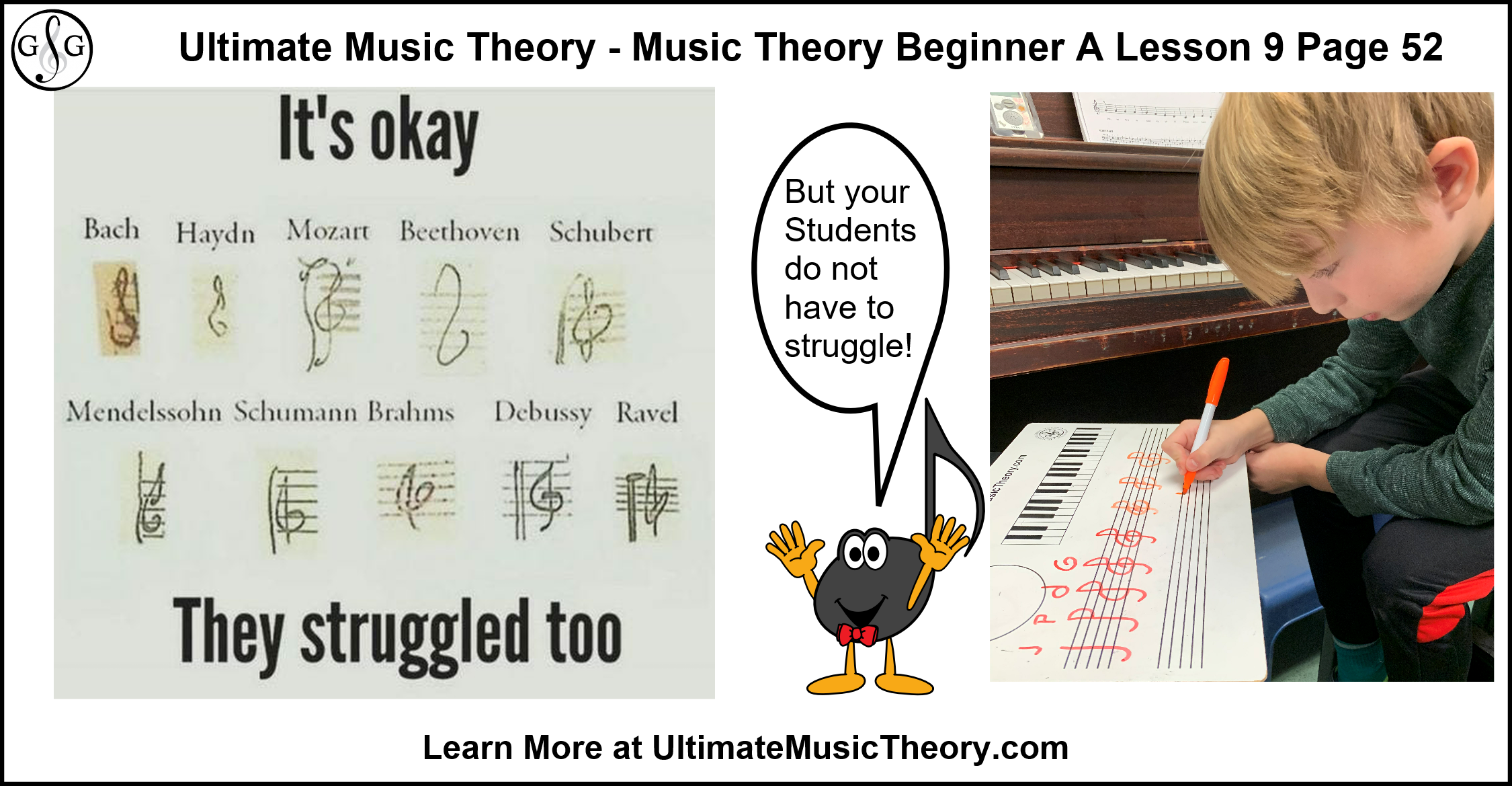
How to Teach Music Theory Beginner A Pages 52 & 53 - Treble Clef
Lesson 9 starts off by teaching how to properly write the Treble Clef. Now, I know that many of our beloved past composers have struggled to write the Treble Clef sign properly. But your Students do not have to struggle! With Ultimate Music Theory, it is as easy as "J - P - d - Circle the G".
In my Blog "Learn How to Draw a Treble Clef", I explain the reason that the Treble Clef should be drawn properly (and how to teach "why" it needs to be written this way). This is a great blog and I encourage you to read it for more insight as to the importance of writing the Treble Clef (Treble Staff) Sign properly.
From my youngest students (age 4) to my oldest students, this is by far the easiest way to learn how to write a proper Treble Clef Sign. I do prefer to have my students complete Pages 52 & 53 at the lesson (after we have practiced writing several Treble Clef signs on our Whiteboard or staff paper).
On the UMT Website, under "Free Resources", we also have Treble Staff Theory Worksheets that are easy to download and print. These are in 2 sizes - Large and Small - so that they can be used by younger and older students. Check them out!
Free Resources Treble Staff Worksheets You can download the large or small Treble Staff worksheets.
You can also get your Ultimate Music Theory Whiteboard to easily teach how to draw the Treble Clef and much more.
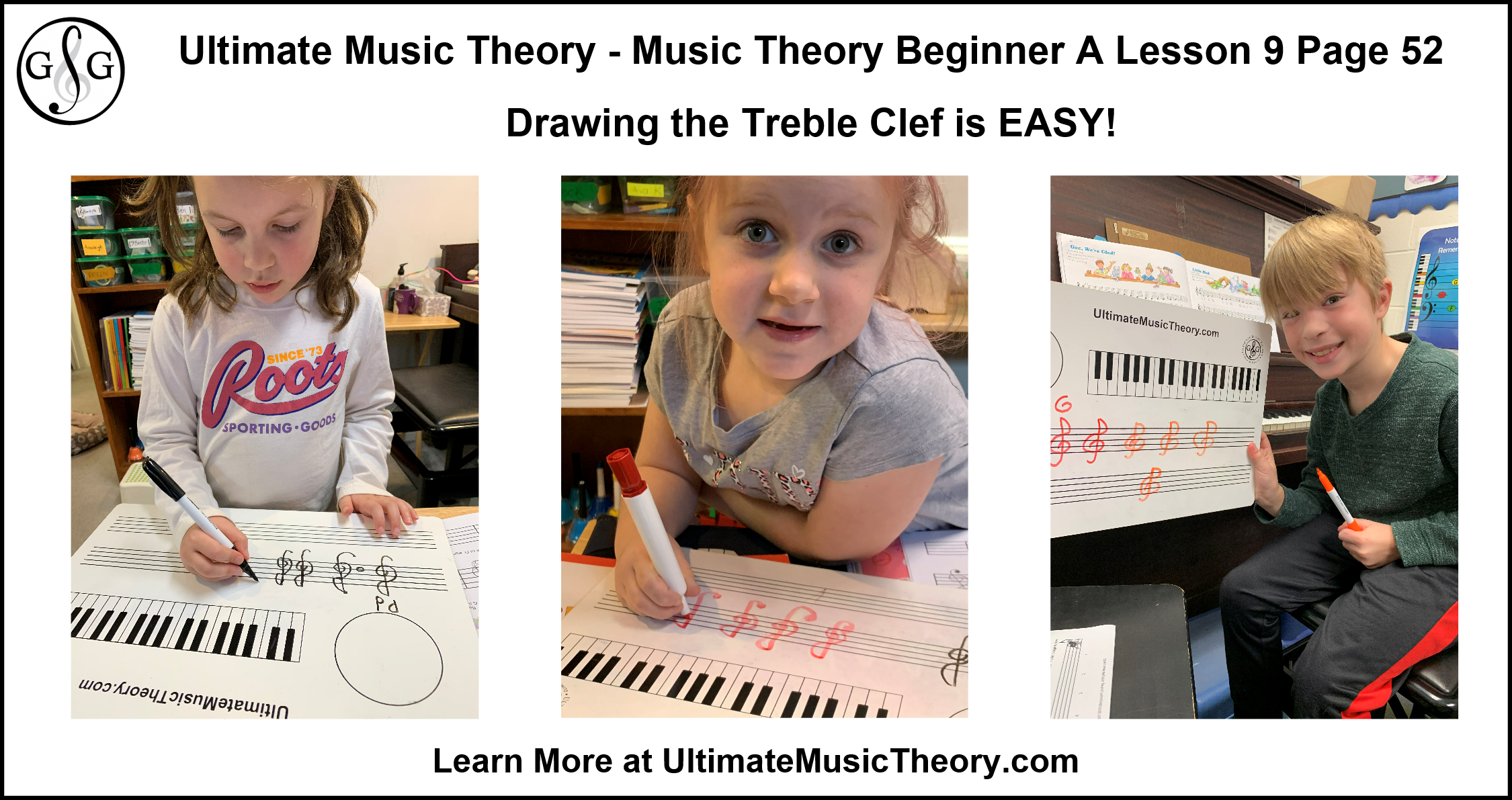
How to Teach Music Theory Beginner A Lesson 9 - Treble Clef Leaps
You may have noticed that we have not introduced the words "Intervals" or the interval numbers yet. This is on purpose. The first step in teaching Intervals is teaching what a distance is. So we started in Lesson 7 with introducing steps.
Children take steps every day. It is a body movement. To understand that a step involves putting one foot down and then the next foot, review with your student how they walk. This is really effective if you can do this exercise on a tiled floor. I don't have a tiled floor in any of my studios, so I use construction paper to create a pattern.
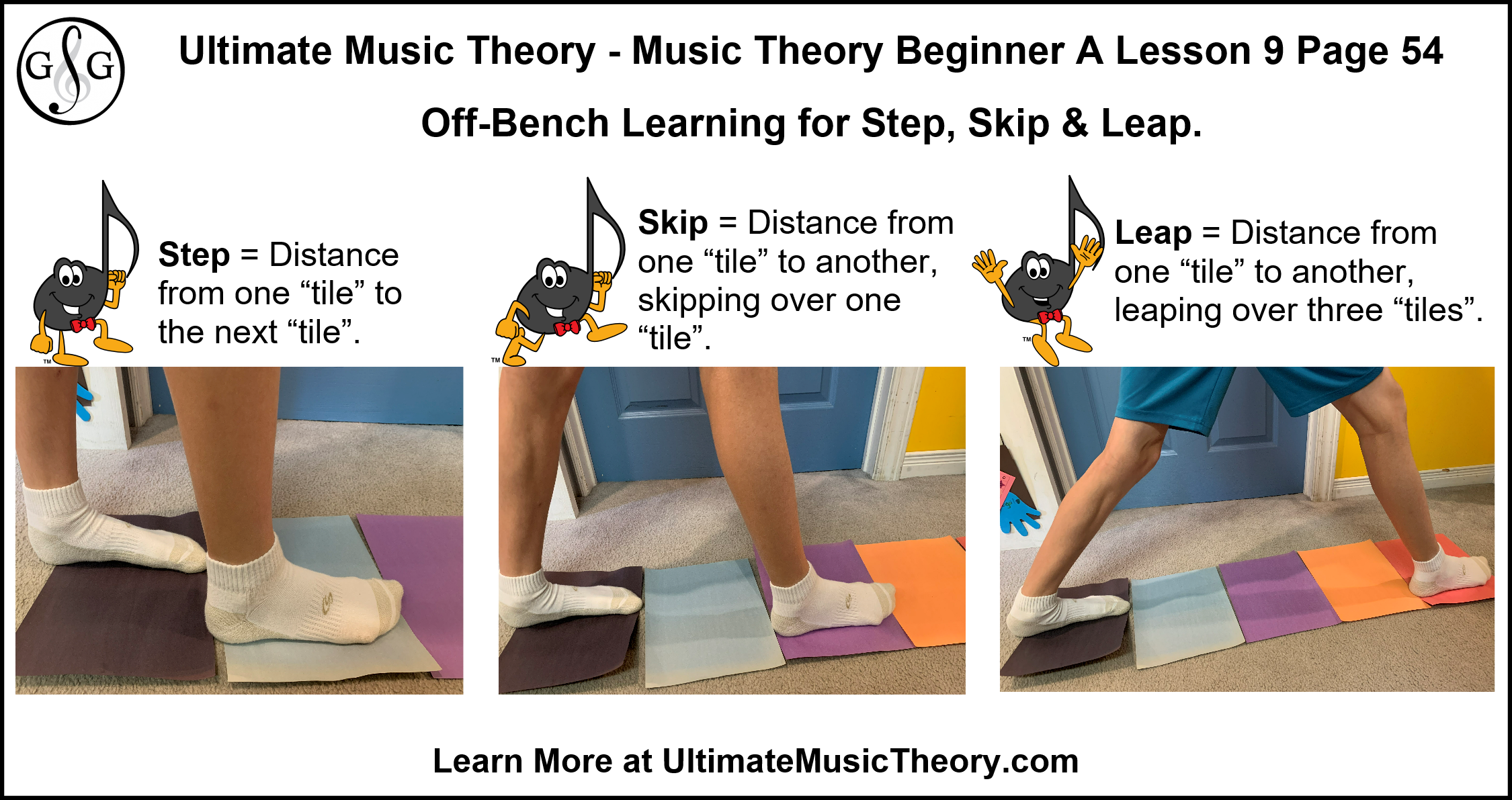
If you only put one foot down, you have not created a distance - you are not moving anywhere. A pattern, a distance, is created when you move from one foot/key/finger to another foot/key/finger.
Please note: For this example, I am only showing the direction "UP". Once your student understands the concept of going UP, please repeat this off-bench activity going DOWN.
A Step = the movement from one key to the next key; the movement from one finger to the next finger; the movement from one "tile" to the next "tile".
A Skip = the movement from one key to another, skipping over one key (one key in between); the movement from one finger to another finger, skipping over one finger (one finger in between); the movement from one "tile" to another "tile', skipping over one "tile" (one "tile" in between).
A Leap = the movement from one key to another, leaping over three keys (three keys in between); the movement from one finger to another finger, skipping over three fingers (three fingers in between); the movement from one "tile" to another "tile", skipping over three "tiles" (three "tiles" in between).
How to Teach Music Theory Beginner A Lesson 9 - Read it. Write it. Play it.
Whether you assign Pages 54 & 55 as homework, or have the student complete the first measure in each question at the lesson, I cannot stress enough how important it is to Read it, Write it and Play it!
Students also benefit from pointing to the notes on the page as they are playing the keys on the piano. This helps them develop their tracking skills (the ability to follow music or words).
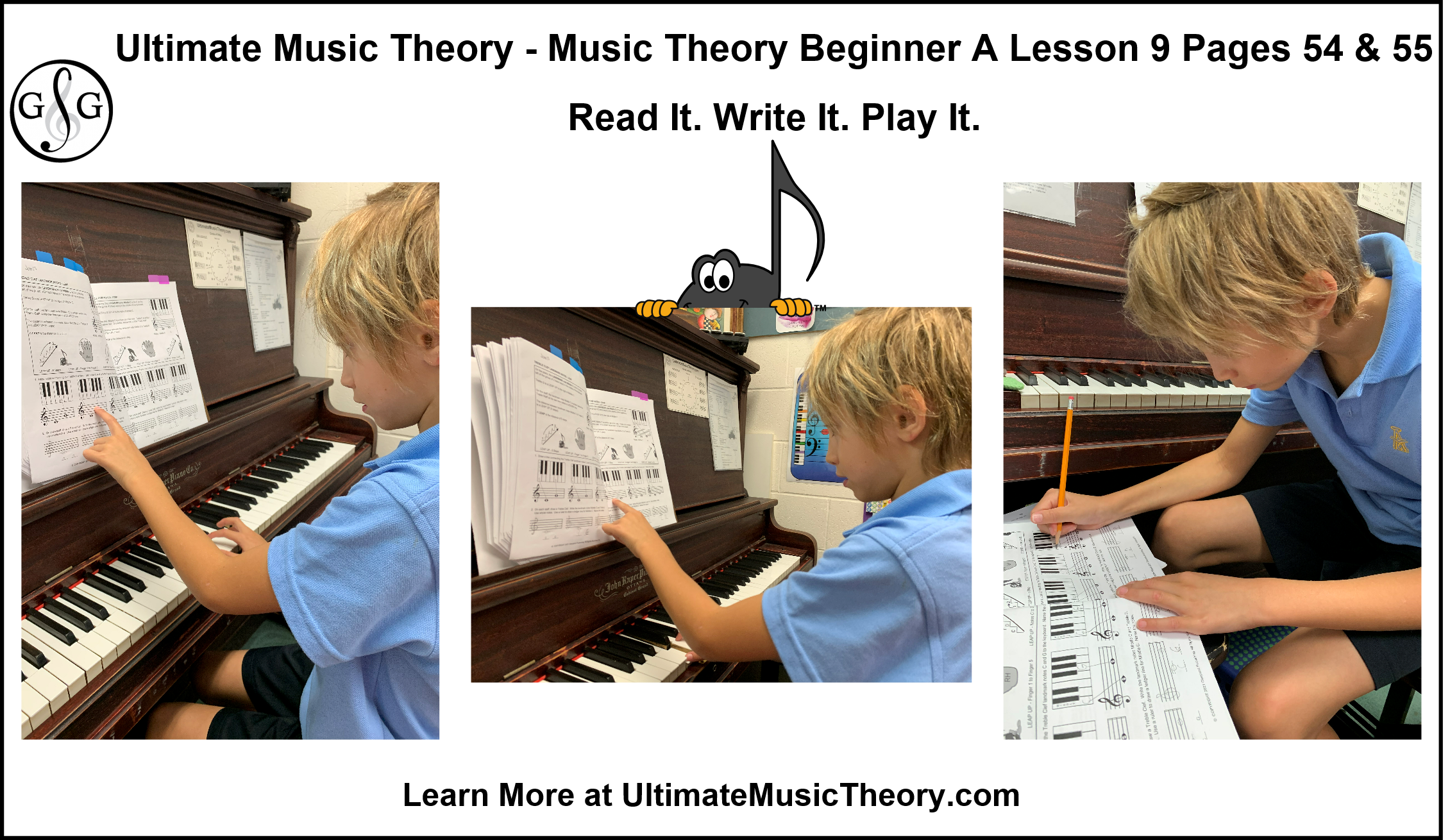
Optional Game Idea - "Step, Skip or Leap Slap"
"Slap" is one of my favorite games to play with my students. For this game, all you need is a flyswatter (that is dedicated to only slapping paper not flies) and your imagination.
At least 30+ years ago (before the invention of home laminators), I created a deck of Musical Alphabet cards using index cards and packing tape. I wrote the letter name on the card and then wrapped each card with packing tape. Voila - "laminated" Musical Alphabet Flashcards!
For this game, "Max the Turtle" sits on C. I then say:
- "Max the Turtle says to Slap the Flashcard a Step Up from C". (Answer - the student would slap the "D" Flashcard.
- "Max the Turtle says to Slap the Flashcard a Skip Up from C". (Answer - the student would slap the "E".)
- "Max the Turtle says to Slap the Flashcard a Leap Up from C". (Answer - the student would slap the "G".)
Then Max the Turtle moves to G and we repeat our Slap the Flashcard game with a Step Down, a Skip Down or a Leap Down.
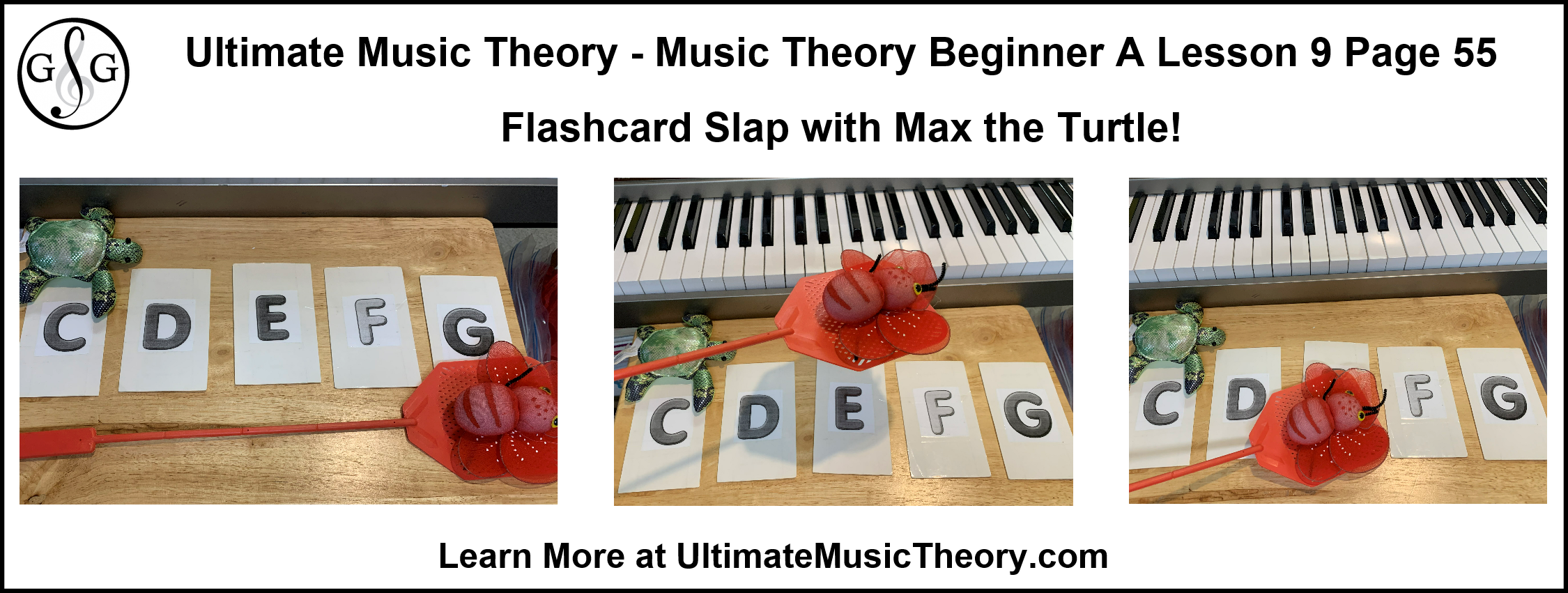
How to Teach Music Theory Beginner A Lesson 9 Pages 56 & 57
At the lesson, I read the "Learning Box" at the top of Page 56 and Page 57 with my Students. We start by reviewing "Finger Steps" on the table top (or lid of the piano). Here is when you can practice playing with a proper hand position.
If the exercise can be played on the piano, it can be tapped on the table top (or piano lid). This builds up dexterity, flexibility and confidence!
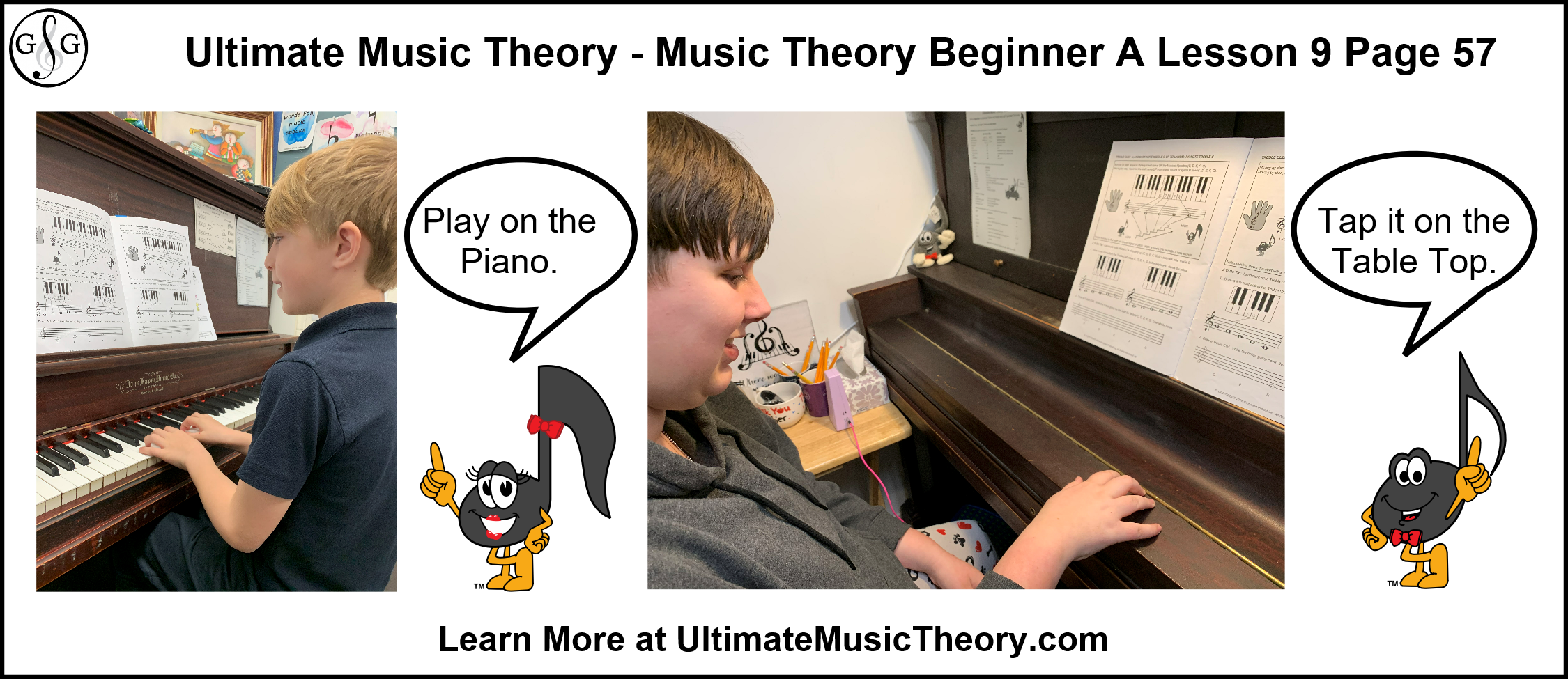
Meet "Max the Turtle" and our Studio Mascots.
My studio has 3 "Mascots" - So-La & Ti-Do are limited edition Stuffies that are now collectors items. Our 3rd Mascot is Max the Turtle.
Max the Turtle is named after my own Yellow-Bellied Slider, "Max". We rescued Max from an owner that was keeping her in a recycling bin in her laundry tub. Max now has a spacious Turtle Tank with Basking Box set up in our Living Room (she likes to watch Jeopardy from her Basking Box).
Max is the best pet. Her diet has been approved by our Vet so that there is zero chance of her transferring salmonella or parasites to anyone who handles her. (She has been fecal and blood tested too.) In other words, she is safe to be handled and she LOVES IT!
We let her out of her tank so that she can crawl around the house. When I am watching tv, she will climb up my pants to cuddle under my neck. She actually plays with the Grandkids, and she loves to have her shell scratched by everyone.
So, of course, we use a "Max the Turtle" stuffy in my studio. I use the stuffed Max to help my students see what a proper piano playing position feels like.
Do you have a Studio Mascot? I'd love to hear about yours in the comments section below!
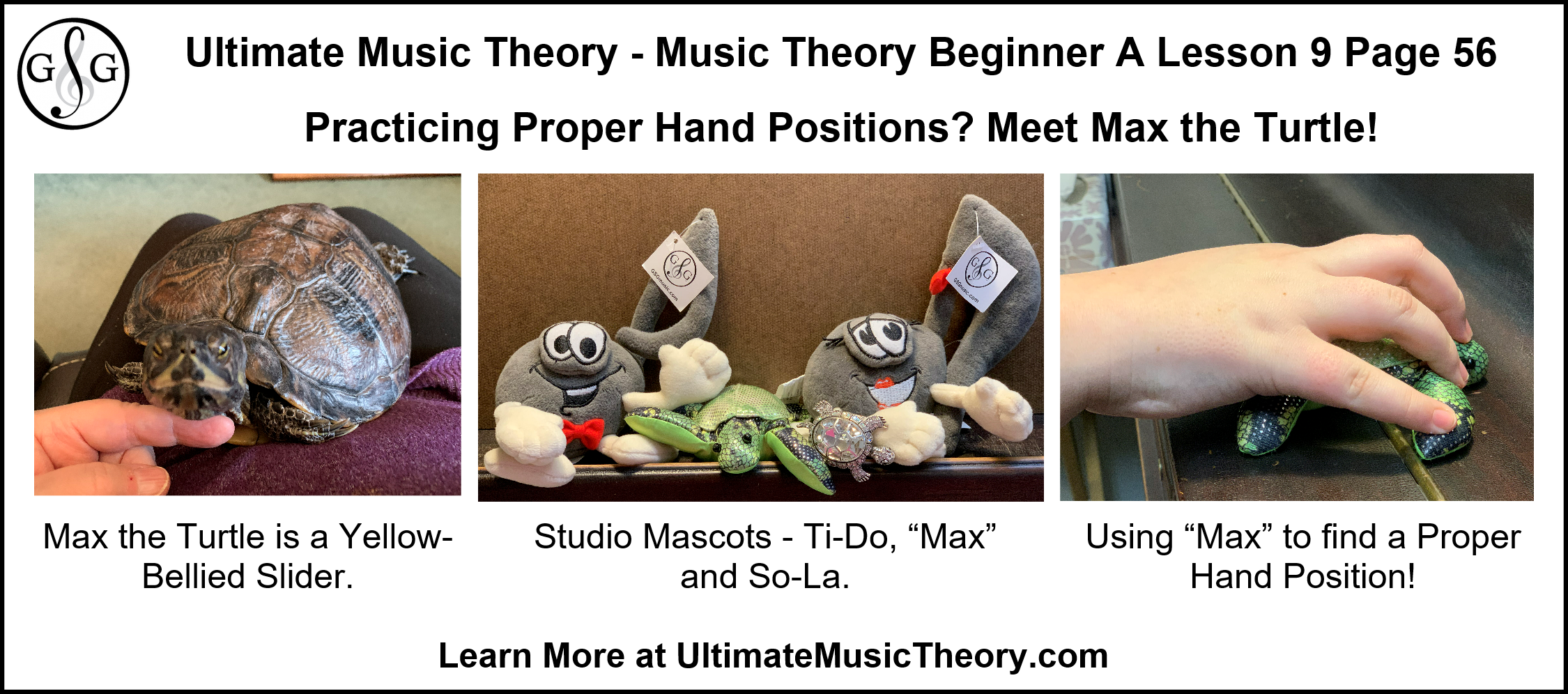
How to Teach Music Theory Beginner A Lesson 9 Pages 58, 59, 60 & 61
Are you in the habit yet of reading and playing each "Learning Box" at the top of the page? For Pages 58 & 59, if you are assigning these pages as homework (which I usually do), I still like to take the minute to have the student point to the notes at the top of the page and then play the patterns.
This is a great time to play more Flashcard Games too. These are at the back of your Workbook. If there is time at the Student's lesson, you can quiz them on the flashcards from Pages 97 (Steps) and 98 (Skips).
Here is a Tip: Cut out these Flashcards from your Teacher's Copy of the Music Theory Beginner A Workbook and laminate them (or wrap each in packing tape) to create a Studio Set.
I usually assign Page 60 as Homework. I remind my students that the title says "Lesson 9 REVIEW with So-La & Ti-Do", and a "review" is not a "final exam". The word "review" means that, if you are having a brain burp (if you can't remember what something is), go back and find the concept to remind your brain what you are doing.
On Page 61, we are really starting to get into Ear Training. This is not easy stuff, so we want to train those ears to hear not only the direction (up or down), but the distance (step or skip). I have a lot of success (and student smiles) when I follow these steps:
- With the student looking at the piano/workbook, point to the 2 patterns in the question. Have the student identify what is the same and what is different between each possible answer.
- Play and sing along with the pattern. For example - for "a", play C - E and sing "Skip Up". Play it again and have the Student join you in singing "Skip Up". Then play E - C, sing "Skip Down, and then have the Student join you in singing "Skip Down".
- The student then covers their eyes or looks away from the piano. Play one of the 2 examples and ask the Student to identify which one you played.
- Before you "lock in their final answer", play the answer again and have the Student sing their answer (Skip Up or Skip Down) as you play it. Does it sound right?
- If the Student has identified the pattern as "Skip Up", but I played the "Skip Down", instead of saying "wrong", I like to say "Let's listen and sing this again". Then we review the sound emphasizing with our body the direction that the Student has selected. Is our body moving in the same direction as the sound? By helping them to see/hear why their answer is incorrect, you are teaching them to explore "why" (instead of just picking the other answer because their first choice was wrong).
Remember, you do not have to be a Pitch-Perfect Singer! You just need to have fun!
And speaking of fun, the Imagine, Compose, Explore! exercise at the bottom of Page 61 can be hilarious! I've had Students create stories where So-La has bounced all the way off the piano, and where Ti-Do is only doing tiny bounces because he's "old like Mme Shelagh". (My students call me Madame Shelagh, as I teach in French and English.)
If your Student struggles to think of an idea for their song/story/sound effects, it is okay to ask them leading questions. For example:
- Who is jumping on the trampoline? So-La or Ti-Do?
- Which fingers are going to be their feet? Fingers 2 & 3 or Fingers 3 & 4?
- Is it a big trampoline or a tiny trampoline? (Are they going to bounce all over the piano or just in one spot?)
- Are they bouncing way up HIGH into the sky or with just little bounces? (How high are their hands going to "bounce" up?)
- Are they going to bounce fast or slow?
There is no "right" or "wrong" when creating an ICE! If your Student has created a fun story to their sounds, I'd love it if you could share it in the comment section.
With a Smile and a Song,
Shelagh McKibbon-U'Ren
The Ultimate Music Theory Workbook Series - Beginner A, B, C, Prep 1, Prep 2, Basic, Intermediate, Advanced and Complete all-in-one Rudiments!

The UMT Workbooks include 12 Lessons & Review Tests, Music Theory Guide & Chart and 80 Flashcards in each workbook.
- 12 COMPREHENSIVE LESSONS - Simplify complex concepts
- GUIDE and CHART - Memory Joggers for fast and easy reference
- 12 REVIEW TESTS - Accumulative study including final exam
Ultimate Music Theory helps students prepare for nationally recognized theory exams, including the Royal Conservatory of Music Exams.
A Proven Step-by-Step Workbook System!
- LEARN FASTER – Use on any device, phone, tablet, computer
- EXPLORE – Identify written & audio notation
- PLAY – Sight Reading and Ear Training Games and much More!
Students will LOVE the UMT Flashcard System (App powered by Brainscape) that correlates to each lesson in the Beginner A, B, C, Prep 1, Prep 2, Basic, Intermediate & Advanced Workbooks.
Have fun building a foundation in Music Theory, Ear Training, and Sight Reading.
The One and ONLY Music Theory App & Matching Workbook!
Get Access To UMT Worksheets, Games, Activities, Posters, Certificates, Courses, Coaching Calls, Community & More!
Ultimate Music Teachers Membership
♪ LEARN ♪ PLAN ♪ TEACH ♪ GROW
The One & ONLY Ultimate Music Teachers Membership
To Become A UMT PRO!
Your Success Path Starts Here - Go To TeachUMT.com Today!
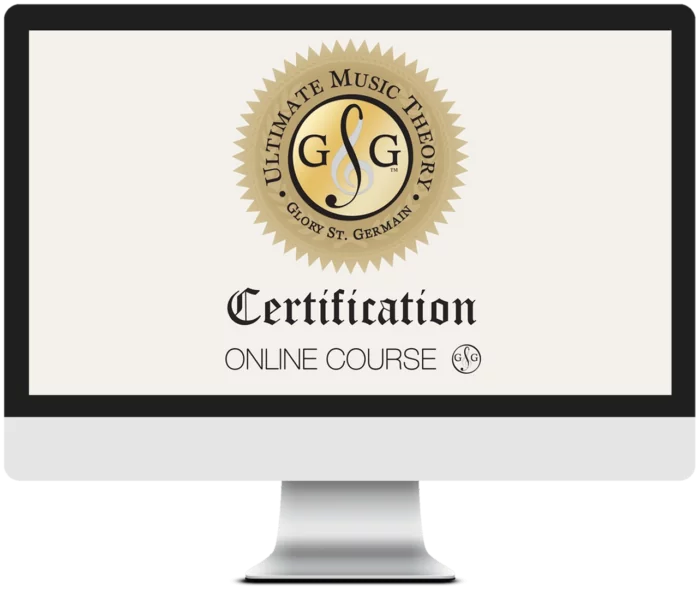
Ultimate Music Theory Certification Elite Educator Program - Online Teacher Training to Elevate Your Income, Impact Your Teaching and Grow Your Expert Music Teaching Business. Get Certified!
Click HERE to discover what you will learn in the Ultimate Music Theory Certification Course. Your professional development Online Teacher Training starts here!
Keep on Learning... With a Smile and a Song!
Shelagh McKibbon-U'Ren

